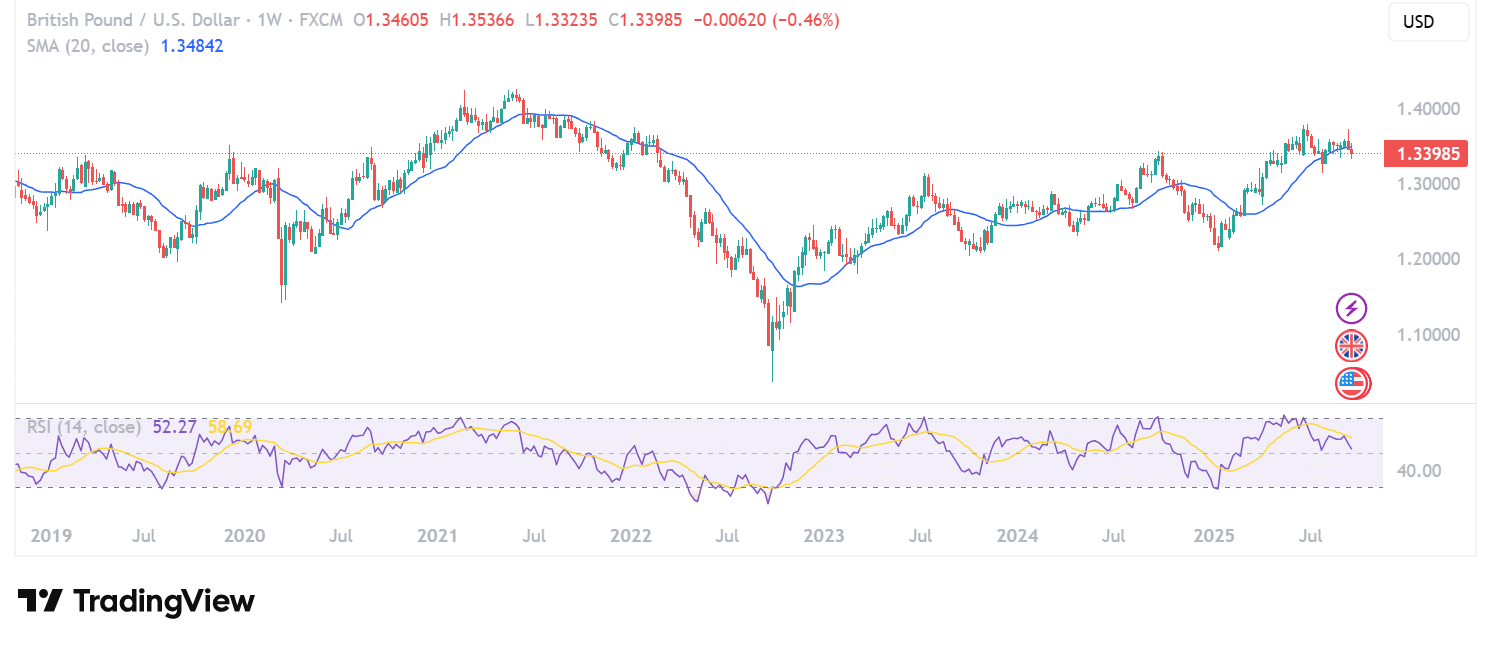British Prime Minister Keir Starmer triggered fury Today as he revealed plans for UK digital ID, but are major banks planning to take the British pound (GBP) digital too?
Britain’s biggest banks have launched live tests of “tokenized” sterling, digital versions of bank deposits designed for faster and more controlled payments.

(Source – GBP USD, TradingView)
Six lenders, Barclays, HSBC, Lloyds Banking Group, NatWest, Nationwide, and Santander, are taking part in the pilot, which is being coordinated by UK Finance. The project began on September 26 and will run until mid-2026.
The tests focus on three use cases: marketplace payments, remortgaging, and digital-asset settlement.
According to UK Finance, the goal is to cut fraud, speed up settlement, and give customers more control over how money moves.
This marks one of the most significant steps yet in the UK’s push toward programmable money. Instead of creating a new currency, tokenized deposits work as digital representations of money already held at banks.
They are expected to play a central role in the country’s broader digital-finance strategy, sitting alongside the Bank of England’s work on digital money and securities.
DISCOVER: 9+ Best High-Risk, High-Reward Crypto to Buy in 2025
Why Does the Bank of England Prefer Tokenized Deposits Over Stablecoins?
Britain’s pilot of tokenized sterling deposits is gathering momentum with backing from top banks and major industry partners.
UK Finance describes the tokens as digital versions of commercial-bank money.
They carry the same protections as regular deposits but come with added programmability, allowing payments to be automated and tailored to specific needs.
The pilot is supported by Quant on technology, EY for advisory, and Linklaters on legal work.
“This project is a powerful example of industry collaboration to deliver next-generation payments,” said Jana Mackintosh, UK Finance’s managing director for payments and innovation.
The Bank of England has also pushed banks toward this model, arguing that tokenized deposits are safer than privately issued stablecoins because they keep funds within the regulated banking system.
According to Reuters, the pilot will expand from marketplace payments into remortgaging and digital-asset settlement. HSBC has signaled that client demand is strongest in cross-border payments, where tokenized deposits could cut costs and settlement times.
DISCOVER: 16+ New and Upcoming Binance Listings in 2025
How Does the UK Regulated Liability Network (RLN) Shape Tokenized Bank Money?
Tokenized sterling deposits are not central bank digital currency (CBDC) or private stablecoins. They are commercial bank liabilities recorded on distributed ledgers, designed to work with today’s payment systems and future tokenized markets.
The initiative builds on the U.K.’s Regulated Liability Network (RLN) trials and sits alongside the Bank of England’s ongoing work on digital money and the Digital Securities Sandbox.
The pilot comes after months of policy signals and fresh funding for supporting infrastructure.
This week, blockchain settlement firm Fnality, operator of the Sterling Fnality Payment System under BoE oversight, secured about $136M from banks and market participants to expand wholesale, tokenized settlement rails in Britain and abroad.
Investors include Bank of America, Citi, and WisdomTree.
Participating banks describe tokenized deposits as an upgrade to existing money rather than a replacement. “The upgrading of bank deposits to a digital form will help ensure commercial bank money remains central to the economy,” said Ryan Hayward, head of digital assets at Barclays.
HSBC called tokenized deposits “an important development in digital money.”
Regulators have stressed that rules for stablecoins will not be finalized until late 2026. But they have encouraged banks to test tokenized deposits under current frameworks.
That approach, together with live pilots, signals that the UK is positioning tokenized bank money as a bridge to a more programmable financial system, one that could coexist with any future digital pound.
The pilot runs until mid-2026. Key indicators will be whether programmable deposits reduce fraud in online marketplaces, shorten mortgage refinancing timelines, and enable instant settlement for tokenized assets.
Markets will also watch for further updates from the BoE on the digital pound and from the FCA on the final stablecoin rulebook.
DISCOVER: 10+ Next Crypto to 100X In 2025
Join The 99Bitcoins News Discord Here For The Latest Market Updates
The post First Digital ID: Is the British Pound Going Digital? Tokenized Sterling Explained appeared first on 99Bitcoins.




